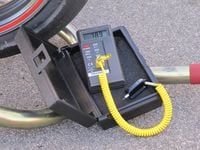Modern race tires can offer amazing traction—if they're at the right temperature. Lap the track with tires that aren't up to temp and traction will suffer, which could result in the common "cold-tire" crash. Overheat your buns and they'll get greasy, likewise resulting in less-than-optimum grip. And traction is only part of the problem with off-temp tires. Flogging tires that are too cold or too hot often causes tears in the tread surface (referred to as cold or hot tearing, depending on the condition that causes it) that can erode your pricey track tires in a matter of laps.
Clearly, getting a grip on tire temperature is key in optimizing traction and getting the most mileage out of your expensive rubber. Experienced riders often rely on seat-of-the-pants feedback, tire-pressure rise from cold, and tread wear to determine if the tires are operating in the right temperature range. But when it came time to dial in the Bridgestone GP3 slicks I run on my Honda CBR250R racebike, I decided to use a more scientific method. That’s when I ordered a tire pyrometer from Intercomp Racing.
Probe-type pyrometers like Intercomp’s are the device of choice for anyone serious about tire temperatures. To get a reading, you turn on the unit and then pierce the tread with the pointed metal probe immediately after coming off the track. (Waiting even a few minutes allows the tires to cool and will give an inaccurate reading. The picture above was taken at the end of the day with a cooling tire.)
Don’t worry, the probe isn’t long enough to puncture the tire, but it is long enough to get a reading of the carcass temperature, which is a much better indicator of the tire’s operating temperature than the surface-temperature reading offered by infrared pyrometers. I typically take readings at the left and right shoulder as well as the center of the tread and then average them out for each tire.
From there I adjust the tire pressure (less pressure to allow more carcass deformation and create more heat, or more pressure to reduce deformation and friction and reduce heat build up) to bring the tire temperatures into range. In time, I’ve learned what the cold- and off-warmer pressures need to be to achieve the ideal off-track operating temperature for maximum grip and optimum wear. And that’s valuable information—for my lap times and my budget.
Intercomp’s pyrometer fits comfortably in your palm and comes with a storage case to protect it at the track. The large digital readout updates quickly and has a handy hold function for momentarily storing the maximum temperature. You can also switch between Celsius and Fahrenheit scales.
Intercomp’s pyrometer is a pretty specialized piece of equipment, and something the casual trackday rider and club racer might not be inclined to buy, especially for $199. But considering race tires can cost over $400 a set and the fact that this tool will help you get better performance out of your buns and prolong their life, it’s a worthwhile investment that has the ability to pay for itself fairly quickly. If $199 is too pricey for your budget, consider splitting the cost among your riding buddies and making the pyrometer a shared resource.
I've touched on a lot of complex topics in this product review. For more detailed info on track tires and the many factors that affect their performance, check out my friend Dave Moss's website, feelthetrack.com.
PRICE: $199
CONTACT: Intercomp Racing (intercompracing.com)
Verdict: A pricey but very valuable tool for anyone that wants to get the most out of their race or trackday tires.














/cloudfront-us-east-1.images.arcpublishing.com/octane/ITNLTIU5QZARHO733XP4EBTNVE.jpg)
/cloudfront-us-east-1.images.arcpublishing.com/octane/VZZXJQ6U3FESFPZCBVXKFSUG4A.jpg)
/cloudfront-us-east-1.images.arcpublishing.com/octane/QCZEPHQAMRHZPLHTDJBIJVWL3M.jpg)
/cloudfront-us-east-1.images.arcpublishing.com/octane/HXOUJXQWA5HBHGRO3EMJIGFMVI.jpg)

/cloudfront-us-east-1.images.arcpublishing.com/octane/3TIWWRV4JBBOLDVGRYECVVTA7Y.jpg)
/cloudfront-us-east-1.images.arcpublishing.com/octane/KIX5O23D5NAIBGFXBN3327DKZU.jpg)
/cloudfront-us-east-1.images.arcpublishing.com/octane/7GJYDUIPXRGMTMQKN6ONYOLBOU.jpg)
/cloudfront-us-east-1.images.arcpublishing.com/octane/MUQLOVLL2ZDGFH25ILABNBXKTI.jpg)
/cloudfront-us-east-1.images.arcpublishing.com/octane/TNOU5DNE2BC57MFPMGN2EIDXAM.jpg)
/cloudfront-us-east-1.images.arcpublishing.com/octane/GTCXACQGJ5HAPDTGWUQKDEH44E.jpg)
/cloudfront-us-east-1.images.arcpublishing.com/octane/S35YGSEMEZB4BLTDJTSZPF4GLA.jpg)
/cloudfront-us-east-1.images.arcpublishing.com/octane/5UOT6HPX2JFMRJAX6EH45AR4MQ.jpg)
/cloudfront-us-east-1.images.arcpublishing.com/octane/OKWOJWAKP5EP3OACCRRWPCIX2Q.jpg)
/cloudfront-us-east-1.images.arcpublishing.com/octane/2WF3SCE3NFBQXLDNJM7KMXA45E.jpg)
/cloudfront-us-east-1.images.arcpublishing.com/octane/G4MG6OUCJNBSHIS2MVVOTPX65E.jpg)
/cloudfront-us-east-1.images.arcpublishing.com/octane/IIGGWFOTOJGB7DB6DGBXCCMTDY.jpg)
/cloudfront-us-east-1.images.arcpublishing.com/octane/QSTCM6AVEZA5JJBUXNIQ3DSOF4.jpg)
/cloudfront-us-east-1.images.arcpublishing.com/octane/U4I7G625B5DMLF2DVIJDFZVV6M.jpg)
/cloudfront-us-east-1.images.arcpublishing.com/octane/B6XD6LS6IVCQPIU6HXDJSM3FHY.jpg)
/cloudfront-us-east-1.images.arcpublishing.com/octane/ICL63FEDDRDTTMINYICCEYGMDA.jpg)
/cloudfront-us-east-1.images.arcpublishing.com/octane/FCGZHQXRBZFLBAPC5SDIQLVF4I.jpg)
/cloudfront-us-east-1.images.arcpublishing.com/octane/WNOB6LDOIFFHJKPSVIWDYUGOPM.jpg)
